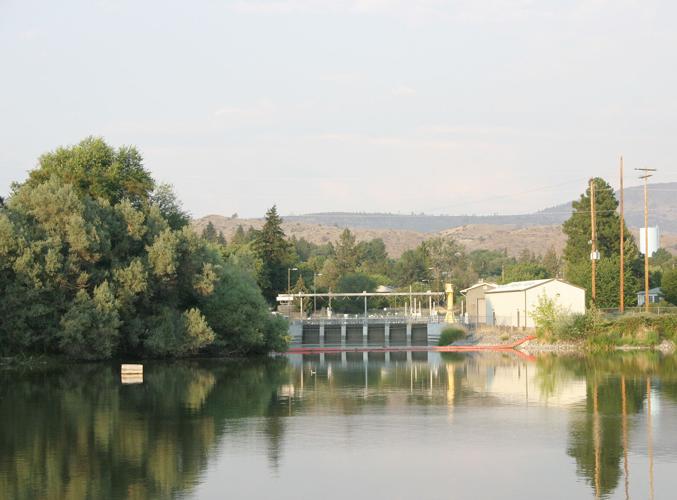https://www.capitalpress.com/ag_sectors/water/reclamation-extends-interim-operations-plan-for-klamath-project/article_f2cf680e-4f10-11ed-9ad5-37dabc7f3b01.html
 <
headgates of A Canal on Klamath
Project <
headgates of A Canal on Klamath
Project
Reclamation extends interim operations plan for Klamath Project
Capital
Press by George Plaven 10/21/22
KLAMATH FALLS, Ore. — The U.S. Bureau
of Reclamation is extending its interim water management
plan for the Klamath Project, despite objections from both
irrigators and tribes working to protect endangered fish.
It is a delicate situation in the
drought-stricken basin straddling Southern Oregon and
Northern California, where there simply has not been enough
water to go around in recent years under the government’s
current arrangement.
Reclamation oversees the Klamath
Project, which provides irrigation water for roughly 200,000
acres of farmland diverted from Upper Klamath Lake, near
Klamath Falls, Ore.
At the same time, Reclamation must
regularly consult with two other agencies — the National
Marine Fisheries Service and U.S. Fish and Wildlife Service
— to ensure there is adequate water for several species of
fish listed under the Endangered Species Act.
Listed species include Lost River and
shortnose suckers in Upper Klamath Lake, as well as coho
salmon in the lower Klamath River.
The resulting biological opinions, or
BiOps, identify minimum water levels needed for each species
to survive. From there, Reclamation determines how much
water is available system-wide based fall and spring
precipitation, and comes up with a yearly allocation for the
Klamath Project.
Interim plan
extended
BiOps for suckers and salmon are
typically updated every five years, incorporating the latest
science and environmental conditions.
However, the most recent negotiations
were scrapped in 2019 after the agencies received “erroneous
data” from an outside consultant during their development.
That has left an interim operations
plan in place since March 2020, which stakeholders have
panned as “unworkable and irrational,” particularly during
drought years. Both the Klamath Water Users Association and
Klamath Tribes urged Reclamation to discard the plan after
it was set to expire Sept. 30.
Instead, the agency has proposed
extending the interim plan through Oct. 31, 2024.
Part of the rationale, according to
Reclamation’s Klamath Basin Area Office, is to allow for
ongoing analysis of how the removal of four hydroelectric
dams on the Klamath River — J.C. Boyle, Copco 1, Copco 2 and
Iron Gate — will affect critical habitat for fish.
Dam removal could begin as early as
next year, and is expected to open about 400 miles of
upstream spawning habitat for salmon.
In a letter sent Sept. 23 to Paul
Simmons, KWUA executive director, and Clayton Dumont,
chairman of the Klamath Tribes, Elizabeth Klein, senior
counselor to Interior Secretary Deb Haaland, said the
department is “committed to improving our year-to-year
engagement” to better understand water needs in the basin.
Klein said the department will convene
two public forums this fall to discuss the latest science
and funding priorities for water projects.
The
bipartisan infrastructure bill that passed in 2021 has
already earmarked $162 million for the Klamath Basin over
the next five years.
Irrigation cut
short
But patience is wearing thin among
farmers and tribal members who argue a better, long-term fix
is sorely needed to maintain their ways of life.
Mired in three consecutive years of
drought, the Klamath Project was initially allocated just
50,000 acre-feet of water in April, about 15% of demand.
Timely spring rains helped increase project supply to 82,253
acre-feet, though water was shut off to the A Canal on Aug.
19.
The shutoff caught farmers by
surprise, who argued Reclamation moved the goalposts by
increasing the end-of-season water elevation required by
suckers in Upper Klamath Lake.
Simmons, with the KWUA, previously said the changes
authorized under the interim operations plan were “far above
any level ever claimed to be necessary” for suckers, while
cutting off access to another 45,000 acre-feet of water for
irrigation.
Meanwhile, farmers scrambled to save
crops already in the ground, in some cases piping
groundwater over a mile to fields growing potatoes and
onions. Water that would normally be delivered to the Lower
Klamath and Tule Lake national wildlife refuges was also
halted, drying habitat for wildlife and migratory birds.
“It seems like, right now, the
administration’s only priority on the Klamath River is
removing the dams,” Simmons said. “It’s removed any
meaningful intention of good water management by good water
managers, which is sorely lacking here.”
Saving suckers
On the other hand, the Klamath Tribes
sued the government in May claiming that any diversions of
water from Upper Klamath Lake for agriculture were in
violation of the ESA. That case is still pending in U.S.
District Court.
Dumont, the tribes’ chairman, said
Reclamation has failed to meet minimum lake levels for
suckers to access shoreline spawning habitat for three
consecutive years. The agency has also missed its targets
for juvenile fish to access summertime wetland habitat for
two of the last three years.
”The
numbers (of fish) just continue to decline,” Dumont said.
“We think the Bureau of Reclamation tends to privilege
irrigators over the ESA, and over fish.”
The
last time there was successful recruitment of juvenile
suckers into the adult population was 1993, said Stan
Swerdloff, the tribes’ aquatics director.
With suckers on the brink of
extinction, Dumont said he hopes the government will have a
new BiOp in place as soon as possible.
”We’re willing to talk to anyone,” he said. “But I think
that, at some point, the federal government is going to have
to show some leadership and make a decision about whether
they’re going to let species go extinct, or insist upon
sustaining agriculture.”
====================================================
In accordance with Title 17 U.S.C.
section 107, any copyrighted material
herein is distributed without profit or
payment to those who have expressed a
prior interest in receiving this
information for non-profit research and
educational purposes only. For more
information go to:
http://www.law.cornell.edu/uscode/17/107.shtml |

